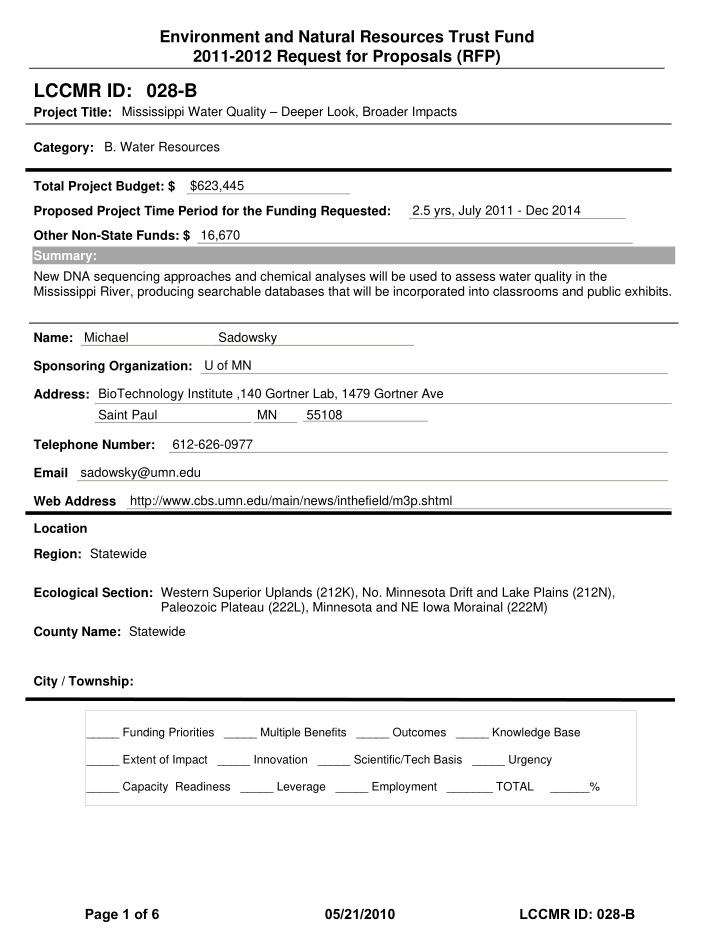



Environment and Natural Resources Trust Fund 2011-2012 Request for Proposals (RFP) LCCMR ID: 028-B Project Title: Mississippi Water Quality – Deeper Look, Broader Impacts Category: B. Water Resources Total Project Budget: $ $623,445 Proposed Project Time Period for the Funding Requested: 2.5 yrs, July 2011 - Dec 2014 Other Non-State Funds: $ 16,670 Summary: New DNA sequencing approaches and chemical analyses will be used to assess water quality in the Mississippi River, producing searchable databases that will be incorporated into classrooms and public exhibits. Michael Sadowsky Name: U of MN Sponsoring Organization: BioTechnology Institute ,140 Gortner Lab, 1479 Gortner Ave Address: Saint Paul MN 55108 612-626-0977 Telephone Number: sadowsky@umn.edu Email http://www.cbs.umn.edu/main/news/inthefield/m3p.shtml Web Address Location Statewide Region: Ecological Section: Western Superior Uplands (212K), No. Minnesota Drift and Lake Plains (212N), Paleozoic Plateau (222L), Minnesota and NE Iowa Morainal (222M) Statewide County Name: City / Township: _____ Funding Priorities _____ Multiple Benefits _____ Outcomes _____ Knowledge Base _____ Extent of Impact _____ Innovation _____ Scientific/Tech Basis _____ Urgency _____ Capacity Readiness _____ Leverage _____ Employment _______ TOTAL ______% Page 1 of 6 05/21/2010 LCCMR ID: 028-B
PROJECT TITLE: Mississippi Water Quality – Deeper Look, Broader Impact I. PROJECT STATEMENT This project provides a more complete understanding of the impact of human activity on the upper Mississippi River, with the goal of improving water quality. We will produce an extensive database cataloging the biodiversity and functions of microbial life in the Mississippi River using a new tool of metagenomic analyses. Metagenomics provides us a way to understand, for the first time, more about the microbiology of the River than we currently know through traditional analyses. The Mississippi River metagenome represents all the DNA in a water sample, regardless of its origin. Information about the diversity and function of microorganisms in the Mississippi, and the types of pathogens present, can be rapidly and directly obtained through the analysis of the DNA sequences in each sample. We will also determine how this data relates to other indicators of water quality, including the input of chemical pollutants, pharmaceuticals, and nutrient run-off. Some of the greatest causes of pollution in the environment are due to the release of sewage, sewage- derived bacteria, and chemicals into waterways. The major human-generated inputs into the Mississippi River Watershed includes nutrients from runoff and sewage treatment facilities, antibiotics and pharmaceuticals, and industrial and agricultural chemicals. These materials not only affect the diversity and functioning of microorganisms in the waterway, but also lead to accelerated aging (eutrophication) of the watershed and pollution with pathogenic microorganisms. Despite our State’s rather intimate relationship with the Mississippi River, including its headwaters and the first navigable locks, we really know little about the impacts of pollution on the functioning of this River watershed and its microorganisms. Microorganisms are the driving force, the engine, that runs the watershed. They are critical to the biological and chemical cycling of elements and materials that keep the planets ecosystems in balance, and to the health and wellbeing of all plants and animals on earth. However, due to major technical limitations, it is estimated that less than 1% of all microorganisms in any environmental sample can be grown in the laboratory and the majority are currently unknown to us. Consequently, current efforts to monitor water quality in the Mississippi using “indicator” bacteria to measure fecal contamination are overshadowed by our lack of knowledge about 99% of the microorganisms in the water, including pathogens. This research project fills this knowledge gap concerning the Mississippi within Minnesota. The cataloging and analysis of the majority of microbes in the water will eventually lead to more confidence in the validity of our regulations and policies, and lead to more targeted remediation efforts by State and Local Agencies. To obtain research data, we plan to engage students at the 7-12, undergraduate, and graduate levels in metagenome data analysis. This data will be available for use in large scale (e.g., Minnesota or national) studies to address human impacts on the River –that is more than a transportation corridor. It is also a watershed and drinking water source for over 50 cities and 18 million people and a habitat providing for fish and wildlife and recreation for millions of people over 31 states. These studies will put Minnesota at the forefront of this important area of environmental research. Project outcomes will provide more insight into selection of proper remediation efforts and the future environmental needs of the watershed to improve water quality. We also believe that one of the best approaches to remediate the Mississippi is to engage the public through education programs; including exhibits at the Science Museum of Minnesota, the Bell Museum, and the Itasca State Park Nature Center. Formal and informal education efforts will engage the state’s citizens in this novel exploration of the Mississippi. II. DESCRIPTION OF PROJECT RESULTS ACTIVITY 1: Analysis of Microorganisms Budget: $416,984 This proposal will fund two and a half years of sampling and metagenome analysis of water samples from the Mississippi River at 10 critical junctures in Minnesota, from Lake Itasca to La Crescent (see attached map), focusing on the headwaters and confluences with other major Rivers. We are currently planning to obtain preliminary data from these 10 sites this summer, and are proposing here to request funding for in depth studies of these sites for two additional years. At each sampling location and time point we will also obtain information on other indicators of water quality, including industrial and agricultural chemicals and pharmaceuticals, inputs that impact microbial diversity and functioning. Page 2 of 6 05/21/2010 LCCMR ID: 028-B
Recommend
More recommend